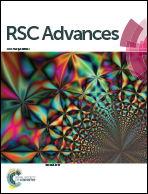Composition controlled nickel cobalt sulfide core–shell structures as high capacity and good rate-capability electrodes for hybrid supercapacitors†
Abstract
Herein, we report a type of core–shell structured NixCo3−xS4 (x = 1, 1.5 and 2) through tuning the ratios of Ni to Co by a simple two-step hydrothermal method. Scanning electron microscopy and transmission electron microscopy images of all the Ni–Co sulfides show high porosity and uniform spherical morphology. Moreover, this study demonstrates that controlling the appropriate ratio of Ni to Co in the core–shell structure is crucial for improving the electrochemical performance in a hybrid supercapacitor. Among them, NiCo2S4 with core–shell structure possesses the highest capacity of 155 mA h g−1, whereas as Ni1.5Co1.5S4 shows the excellent rate-capability of up to 80% from 1 to 20 A g−1 and cycling stability, which retains 74% after 2000 cycles. Therefore, tuning the metal element contents provides a feasible approach to achieving the desired high-rate performance and cycling stability of electrode materials in polynary metal sulfides for hybrid supercapacitors.


 Please wait while we load your content...
Please wait while we load your content...